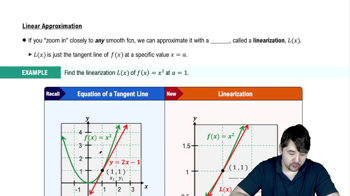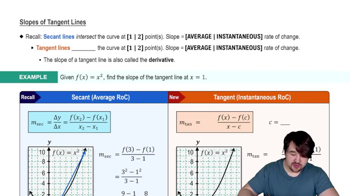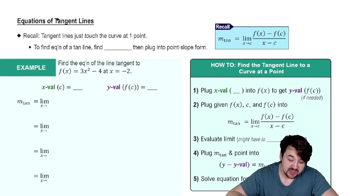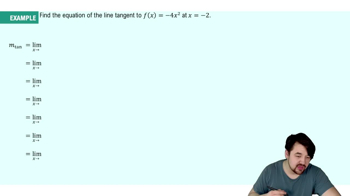Table of contents
- 0. Functions7h 52m
- Introduction to Functions16m
- Piecewise Functions10m
- Properties of Functions9m
- Common Functions1h 8m
- Transformations5m
- Combining Functions27m
- Exponent rules32m
- Exponential Functions28m
- Logarithmic Functions24m
- Properties of Logarithms34m
- Exponential & Logarithmic Equations35m
- Introduction to Trigonometric Functions38m
- Graphs of Trigonometric Functions44m
- Trigonometric Identities47m
- Inverse Trigonometric Functions48m
- 1. Limits and Continuity2h 2m
- 2. Intro to Derivatives1h 33m
- 3. Techniques of Differentiation3h 18m
- 4. Applications of Derivatives2h 38m
- 5. Graphical Applications of Derivatives6h 2m
- 6. Derivatives of Inverse, Exponential, & Logarithmic Functions2h 37m
- 7. Antiderivatives & Indefinite Integrals1h 26m
- 8. Definite Integrals4h 44m
- 9. Graphical Applications of Integrals2h 27m
- 10. Physics Applications of Integrals 2h 22m
2. Intro to Derivatives
Tangent Lines and Derivatives
Problem 3.2.42
Textbook Question
Consider the line f(x)=mx+b, where m and b are constants. Show that f′(x)=m for all x. Interpret this result.
 Verified step by step guidance
Verified step by step guidance1
Step 1: Recall the definition of the derivative. The derivative of a function f(x) at a point x is defined as the limit of the average rate of change of the function as the interval approaches zero: f'(x) = \lim_{h \to 0} \frac{f(x+h) - f(x)}{h}.
Step 2: Substitute the linear function f(x) = mx + b into the derivative definition. This gives us f'(x) = \lim_{h \to 0} \frac{(m(x+h) + b) - (mx + b)}{h}.
Step 3: Simplify the expression inside the limit. The terms b and -b cancel out, and we are left with f'(x) = \lim_{h \to 0} \frac{mx + mh - mx}{h}.
Step 4: Further simplify the expression. The terms mx and -mx cancel out, leaving f'(x) = \lim_{h \to 0} \frac{mh}{h}.
Step 5: Simplify the fraction \frac{mh}{h} to m, since h/h = 1 for h ≠ 0. Therefore, f'(x) = m for all x. This result shows that the slope of the line, m, is constant, and the derivative of a linear function is the slope of the line.
 Verified video answer for a similar problem:
Verified video answer for a similar problem:This video solution was recommended by our tutors as helpful for the problem above
Video duration:
2mPlay a video:
Was this helpful?
Key Concepts
Here are the essential concepts you must grasp in order to answer the question correctly.
Derivative
The derivative of a function measures the rate at which the function's value changes as its input changes. It is defined as the limit of the average rate of change of the function over an interval as the interval approaches zero. For a linear function like f(x) = mx + b, the derivative represents the slope of the line, which is constant.
Recommended video:

Derivatives
Linear Functions
A linear function is a polynomial function of degree one, represented in the form f(x) = mx + b, where m is the slope and b is the y-intercept. The graph of a linear function is a straight line, and its slope (m) indicates how steep the line is. Since the slope is constant, the derivative of a linear function is the same for all values of x.
Recommended video:

Linearization
Interpretation of the Derivative
The derivative can be interpreted as the instantaneous rate of change of a function at a given point. In the context of the linear function f(x) = mx + b, the result f′(x) = m indicates that the rate of change is constant across all x-values. This means that for every unit increase in x, the function f(x) increases by m units, reflecting the uniform behavior of linear functions.
Recommended video:

Derivatives

 5:13m
5:13mWatch next
Master Slopes of Tangent Lines with a bite sized video explanation from Nick
Start learningRelated Videos
Related Practice




